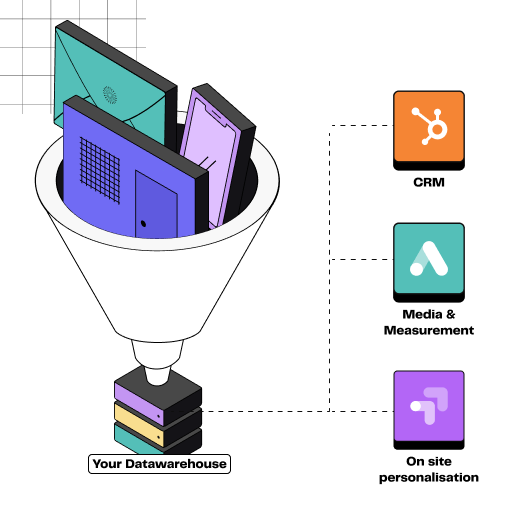
Collecting data in a post-cookie era
6min • Last updated on Jun 17, 2025

Aïda Mansour
Operation Manager
It’s a fact all marketers agree on: online acquisition has become more complex. With the gradual disappearance of third-party cookies, retargeting has lost its effectiveness. And the leads reached by campaigns are becoming less and less relevant.
It all started with ad blockers, which prevented companies from gaining a detailed view of a visitor’s online journey. Over time, more and more users adopted them.
Then, browsers like Safari, Firefox, and Brave, as well as mobile operating systems like iOS, also introduced limitations on tracking. The situation worsened for marketing professionals. Some are already nostalgic for the Cookie Era, when things were better with a clearer view of how to activate their audiences.
Better? It reminds me of the dialog between Luke & Yoda on the dark side being better.

Are cookies the dark side of marketing?
Using cookies was straightforward and made things easier and quicker, so they were more seductive. In a way, they helped lower the barrier to efficient online marketing and better customer acquisition.
You could have a view of what your visitors were doing elsewhere. All you had to do was to attach this little string, that magic pixel Facebook developed, or the javascript snippet pushed by Google.
Tracking visitors was not perfect, but you could easily have all the steps. You could even have a solution for attribution.
With cookies, they knew it all.. Not you!
That perspective is slightly flawed. For one, you did not have that view. You would get the information those tech behemoths doing the tracking would provide you. For free? Well, usually, when lunch is free, it means you are the lunch.
So they pumped you up with some data you could use on their platforms to buy more ads. The art of analytics and getting to know your customers were in their hands. The data you let them have improved their understanding of your customers and your spending on their platform.
Then a wind of change blew on all this system. With the increasing usage of ad blockers and compliance-driven strategic moves of Safari, iOS, and uncertainties about Chrome, the system is teetering on the brink of blind investment.
The bad news: you need to act now or risk seeing your costs rise even further. The good news is you will now be in charge of organising this online acquisition, and no one else knows your business as much as you do and has the drive to improve it!
The endgame of Google or Meta was to sell more ads, not to improve your business, even if there is some overlap there. Remember the Google attribution rule where the last click wins, and that one is often related to a search term.
Opportunities to dig into your website and server-side data
The other good news when reflecting on this new cookieless world is that marketing peers have been doing this for years. And even before the times of the internet.
There are mechanisms to try to put data where it might look hard to do so. For example, mail-order companies used to put discount coupons to find the origin of the lead and also put codes in the “reply bulletin” you would send back.
So these end up being today's UTMs in links and landing pages. That data is already a good start to a better understanding of your customers, along with navigation data on your website.

Here are some thoughts on what you can do by spending time working on the quality of your website data - and maybe you already do these things, but just in case, here they go :
Improve your understanding of your personae by digging into the website visitor behaviour: which pages they spend time on, what are their routes on the website lead to the most conversion?
The last page before conversion might often be the same (for instance, the pricing page) - then which landing page did they arrive on? Which blog post or solutions page did they read longer than the others?
Identify pages with higher bounce rates or lower engagement to improve them and get a better experience for your visitors on your website.
Analyse the behaviour of those users that abandon their shopping carts. Is there a pattern here you can leverage?
The more, the merrier! Increase conversion and retention with your data warehouse
Things become increasingly interesting when mixing website data with other information you might have. Many companies have a CRM with information related to customers and prospects, typically after sign-up. And many will also use email to maintain communication with customers. Opportunities become exceptional when you use all these together.
For instance, a credit underwriter would contact you to offer a restructuring when collecting churn-related information, such as a call to customer service to ask for your payment schedule.
The CRM has information on what was bought, when, and maybe even information on margins. There are many types of campaigns and actions you can build based on effective audience strategies.
For example, you can isolate an audience of customers of product category 1 (CRM), and who have interacted with pages of product category 2 (website data or email nurturing clicks) that you will retarget with category two products by email or any other means.
This is about finding an interesting campaign for customers based on actions and interests. The possibilities are endless.
The variables to define an audience that will be put in action are what they did on your website, what they bought when they did so, what they have been looking at… and even some additional event-based information (stock levels? retailing events?) or offline interactions with your team. Each data source is interesting, but together they become very powerful if you can action them.
Data warehouse : a large store of data accumulated from a wide range of sources within a company and used to guide management decisions.
Oxford Languages
💡If you understand the importance of a single source of truth, but don't know how to build it, don't hesitate to consult our resource on technical challenges for building a data warehouse.

Activating your data from the data warehouse
The combination of a data warehouse and a Reverse ETL process allow to build a custom Customer Data platform, also known as "Composable CDP".
Your data has to be unlocked and activated. Once it is connected together, you build specific audiences and then put them into action. This is our vision of what marketing data should be doing:
A specific audience is sent to a dedicated channel where it receives a tailored message. A lot of effort has been put in place to get that customer to sign-up and provide you with his contact, whether by email or phone.
Now is the time to send him value-added communication that makes sense for him and yields good returns for you. Spend time on the messaging, the offering, the channels used, and the creativity / design.
Measure and improve.

Data Activation
The opportunity is for your team and yourself to put your thinking into action. Activation platforms such as Google Ads or Meta Ads should be kept to what they are good at serving ads. You stay in charge of what you do and put your thoughts and data in motion by creating customer profiles or audiences across all of your channels.
There are many ways to do that, to create efficient customer experiences. We will work on giving you more thoughts. A first step could be to check how to work with conversion APIs.
















